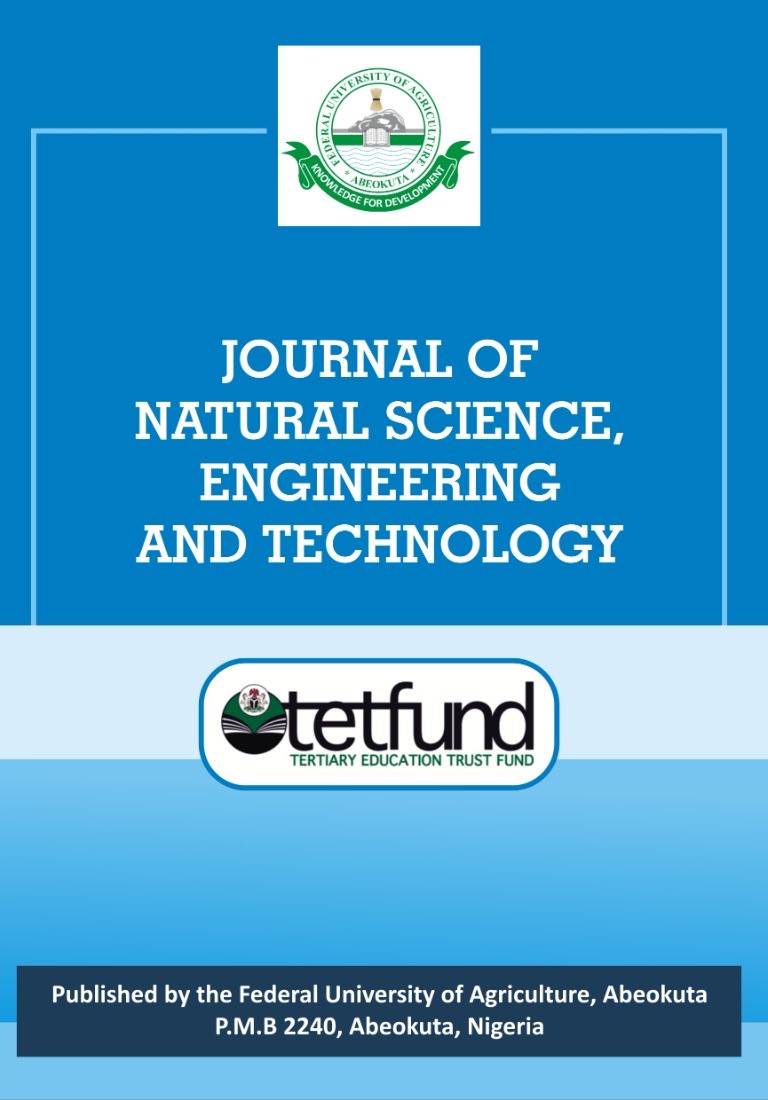PALYNOLOGICAL FEATURES OF Senna occidentalis L. IN FOUR VEGETATION ZONES OF OGUN STATE, NIGERIA
Keywords:
Senna, palynology, vegetation, taxonomyAbstract
Pollen morphology is an important taxonomic character that can provide insights into the variability
and adaptation of plant species in different environments. This study aimed to analyze the pollen mor-
phological variation of Coffee senna (Senna occidentalis L). accessions across four vegetation zones
in Ogun State, Nigeria. Mature anthers were collected, and standard palynological procedures were
followed to examine the pollens using light microscopy. Pollen size, shape, aperture, exine pattern,
and thickness were compared across the four zones. Statistical analysis using SPSS version 27.0
revealed significant variations (p≤0.05) in pollen size, colpi size, and exine pattern across the zones.
Pollen grains were oblate-spheroidal in shape, with sizes ranging from 27.63 to 36.73 μm (polar axis)
and 25.7 to 33.7 μm (equator diameter). The aperture was 3-colporate in all zones, but with distinct
ora in colpi in the rainforest and syncolporate in the mid-rainforest zone. Exine patterns showed slight
variations, with slightly coarse reticulation in the rainforest and fine reticulation in the other three
zones. The distinguishing characters of S. occidentalis pollen across the zones were pollen size (polar
axis and equator diameter), colpi length and width, and exine pattern. These findings reveal the diag-
nostic features of S. occidentalis pollen with taxonomic significance.
References
Borokini, T. I. and Ayodele, A. E. 2012. Pollen morphology of Tacca leontopetaloides (L.) Kuntze in Nigeria. African Journal of Plant Science 6(1): 43-47.
Burkill, H.M. 1995. The useful plants of West Tropical Africa. (2nd Edition): Royal Botanic Gardens Kew. 654-670.
Ejsmond, M. J., D. Wronska-Pilarek, A. Ejsmond, D. Dragosz-Kluska, M. Karpin´ ska-Kołaczek, P. Kołaczek, and J. Kozłowski. 2011. Does climate affect pollen morphology? Optimal size and shape of pollen grains under various desiccation intensity. Ecosphere 2(10):117.
Essien, B. C. and Fatoyinbo, S.O. 2022. Pollen Morphological Study of Some Selected Flowering Plants within Adekunle Ajasin University Main Campus, Akungba-Akoko, Ondo State, Nigeria. European Journal of Botany 1(1): 9-13.
Faegri, K., and Iversen, J., 1992. Textbook of Pollen Analysis, fourth revised edition. New York: Hafner Press, 295pp.
Fernandez-Pacella, L. 2014. Pollen morphology of species of genus Senna (Fabales: Fabaceae) in Southeast Ibera, Corrientes, Argentina. Revista de Biologia Tropical 62(2): 769-82.
Ferreira, K., Torres, G., deSousa, S. and dos Santos, A. 2010. Karyotype, meiotic behavior and pollen features of Senna occidentalis. Biologia 65(5): 1-7.
Karna-Mallick, P. 2019 Morphological studies of pollen grains in angiosperms. International Journal of Applied Science and Biotechnology 7(3): 354-358.
Mander, L., Parins Fuk chi, C., Dick, C.W., Punyasena, S.W., Jaramillo, C. 2021. Phylogenetic and ecological correlates of pollen morphological diversity in a Neotropical rainforest. Biotropica. 53: 74–85.
Mazari, P., Liu, Q., Khan, M., Sadia, S. and Ahmad, L. 2017 Pollen Morphology and Pollen Fertility Estimation of Three Medicinal Plant Species of Hypericum L. from Kaghan Valley, Northern Pakistan. American Journal of Plant Sciences, 8: 3073-3083.
Nnamani, C. V, and Onu. E. 2012. Pollen Morphology of Some Members of Nigerian Clusiaceae and Its Taxonomic Significance. IOSR Journal of Pharmacy and Biological Sciences 3(3): 14-19.
Nnamani, C. V, and Onu. E. 2014. Taxonomic Values of Pollen Features in Sanna Genus (Fabaceae) from South-Eastern Nigeria. IOSR Journal of Pharmacy and Biological Sciences 9(6): 54-59.
Orijemie, E.A. 2018. Pollen morphology of three Caesalpinioideae (leguminosae) ornamental species in Nigeria. Nigerian Journal of Botany, 31(2): 273-283
Sarkar, B., Bera, S., Chowdhury, M. and Das, A. P. 2016. Variations in external and pollen morphological structures among four species of Terminalia L. (Combretaceae) from Terai-Dooars region of West Bengal, India. Pleione 10(2): 344 - 350.
Sowunmi, M. A. 1973 Pollen Grains of Nigerian Plants, Grana, 13(3): 145-186.
Sultan, S. E. 2000. Phenotypic plasticity for plant development, function and life history. Trends in Plant Science 5 (2): 537-542

